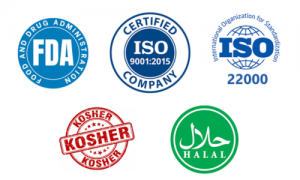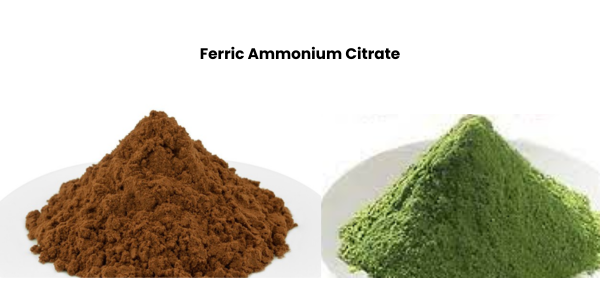Case Study: SCC Supplies Ferric Ammonium Citrate with 20.5-22.5% Iron Content
Stanford Chemicals Company (SCC) is a global leader in hyaluronic acid, plant active ingredients, and food additives. We supply a customer with ferric ammonium citrate with 20.5-22.5% iron to fulfill their needs for the manufacture of high-end pet feed.
Notably, this product has been certified by the FDA, ISO9001, ISO22000, KOSHER, and HALAL, which proves that it adheres to the highest global standards for pet foods. This is a testament to SCC’s zeal to strive for scientific innovation, but at the same time, not forget practicality.
Case Study: Ferric Ammonium Citrate with 20.5-22.5% Iron to Meet Customer Needs
The Challenge: Higher Iron Content Than Market Standards
Food additive commercial brown ferric ammonium citrate usually has an iron content of 16.5% to 22.5%. It is a mild iron fortifier and is superior in safety and palatability. A manufacturer of pet feeds approached us for raw material of higher iron concentration (20.5-22.5%). The higher iron concentration will allow more iron to be supplied at the same dosage rate, thus being more appropriate for premium product production.
SCC’s Solution: Ferric Ammonium Citrate with 20.5-22.5% Iron
To meet the desired iron content, we improved the process of crystallization to eliminate moisture and impurities. Each batch of production was tested for iron content certification, as well as final quality check before dispatch. The product was thoroughly checked to ensure compliance with FDA regulations, ISO 9001/22000 quality systems, and KOSHER/HALAL certification.
Results: Meeting Customer Expectations
The optimized ferric ammonium citrate consistently hit the target iron content range and showed better stability. This third-party certified product is a source of a high-iron ingredient for pet food processors with rigorous standards of quality ensured by total documentation, such as Certificates of Analysis (CoA) and quality management certifications.
* If you’re seeking high-purity food additive ingredients, consult SCC for customized solutions.
What is Ferric Ammonium Citrate?
Ferric ammonium citrate is a compound formed by the reaction of citric acid, iron ions, and ammonia, belonging to the category of organic iron. It is basically an iron supplement of chemical synthesis origin that has widespread usage in the food industry as well as the pharmaceutical industry.
Ferric ammonium citrate is typically classified into two grades based on iron content and application: brown ferric ammonium citrate and green ferric ammonium citrate. Their iron content requirements are as follows:
- Brown Ferric Ammonium Citrate: Also known as Ammonium Iron (III) Citrate, usually 16.5%~18.5% iron content, with the chemical formula C₉H₁₁FeN₂O₈·2H₂O. Specifications for food-grade reddish-brown ferric ammonium citrate require an iron content between 16.5% and 22.5%.
- Characteristics:Contains trivalent iron (Fe³⁺), appears reddish-brown or brownish-red, and is highly soluble in water.
- Applications:Primarily used in medical iron supplements and food additives.
- Green Ferric Ammonium Citrate: Usually 14.5%~16.0% iron content.
- Characteristics:Contains some divalent iron (Fe²⁺), appears green or bluish-green, and is highly photosensitive.
- Applications:Mainly used in photosensitive materials (e.g., blueprint paper) and laboratory reagents.
What Are the Benefits of Ferric Ammonium Citrate?
The primary benefit of ferric ammonium citrate is its iron-supplementing function. Iron is an essential trace element, and it plays a crucial role in hemoglobin production, oxygen transportation, and the metabolism of cells. When you frequently experience fatigue, dizziness, or pale complexion, this may be a sign of iron-deficiency anemia. When this happens, ferric ammonium citrate proves to be very effective. Given this functional advantage, ferric ammonium citrate has also been used as a fortification agent in cereals, infant formula, and various nutritional products to enhance their iron content.
Beyond iron supplementation, it offers other benefits:
- Antioxidant Properties:It can delay fat oxidation in certain foods, extending shelf life.
- Color Enhancement:In some cured foods, it helps maintain a red appearance, making the product more visually appealing.
How Does Ferric Ammonium Citrate Compare to Other Iron Salts?
In addition to ferric ammonium citrate, other common iron supplements include ferrous sulfate, ferrous gluconate, and amino acid-chelated iron. How does ferric ammonium citrate compare? Below is a comparison of these four iron salts in terms of bioavailability, gastrointestinal irritation, stability, and price:
| Iron Salt | Bioavailability | GI Irritation | Stability | Price |
| Ferric Ammonium Citrate | High (~90%) | Low | Excellent | Moderate |
| Ferrous Sulfate | Moderate (60-70%) | High | Fair | Low |
| Ferrous Gluconate | High (~80%) | Moderate | Fair | Moderate |
| Amino Acid-Chelated Iron | High (80-90%) | Moderate | Good | High |
From the table, we can see the advantages of ferric ammonium citrate:
- High Absorption Rate: As a highly soluble iron salt, ferric ammonium citrate is marked by extremely high bioavailability within the human body. With rates of absorption reaching up to 90%, it is transformed more efficiently into biologically active iron for physiological use.
- Gentle on Digestion: Compared with ferrous sulfate, ferric ammonium citrate causes minimal gastrointestinal irritation, being more tolerant in the gut. This makes it particularly suited for individuals prone to GI upset from iron supplements.
- Oxidation Resistance: The product exhibits superior oxidative stability under room conditions. Not only does this promote shelf life, but it also retains potency even when air is exposed during use, inhibiting active ingredients from breaking down.
Is Ferric Ammonium Citrate Safe?
As a synthetic compound used in food applications, safety is crucial. Ferric ammonium citrate has received safety approval from major food regulatory authorities including the FDA and EFSA. This certification ensures its safe use both as a dietary supplement and nutritional additive. However, excessive iron intake causes side effects ranging from upset stomach, diarrhea, or even iron poisoning. It should therefore be consumed within the appropriate recommended dosages.


